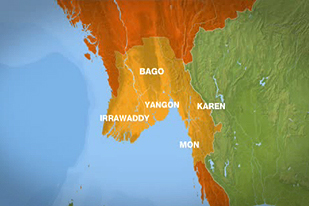Myanmar death toll 'more than 120,000 estimate'
Burma Raises Cyclone Death Toll
to 78,000 But True Figure Much Higher Saturday 17 May 2008 The official total for the dead in Burma's cyclone disaster jumped to 78,000 yesterday, up from 43,000. The new figure was announced by Burmese state television, which said the number of missing had risen from 28,000 to 56,000. Nobody knows what relation these figures may bear to reality because access to the stricken zone is tightly controlled by the military junta, though both the Red Cross and the United Nations believe the true figure is much higher even than the new official claims. The survivors, up to 2.5 million of them, face an increasingly grim struggle for survival. A Reuters reporter who drove from Rangoon to Kuanyangon, about 60 miles south of the former capital, described the dispossessed lining the road, praying for aid. "Without clothes or shoes, the thousands of men, women and children made destitute by the cyclone could only stand in the mud and rain of the latest tropical downpour, their hands clasped together in supplication at the occasional passing aid vehicle," the reporter wrote. "Any car that did stop was mobbed by children, their grimy hands reaching through a window in search of bits of bread or a T-shirt." A Burmese volunteer who had travelled to the town commented: "The situation has worsened in just two days. There weren't this many desperate people when we were last here." The petitioning of the desperate along the region's roads gave the lie to the regime's claim that the crisis is fully under control. The regime appropriates any aid and allows no checks on what becomes of it subsequently. Burma has one of the world's worst records for corruption, according to Transparency International. As the Burmese authorities continued to guard the disaster area like a prison camp, the Red Cross warned that what the most desperate need now is for clean drinking water, if survivors are not to fall victim to dysentery and other diseases. "If clean water isn't available, it's going to be the biggest killer in the post-disaster environment," Thomas Gurtner, the head of operations for the Red Cross, said in Geneva. "Food is urgent, but you die in three days from acute diarrhoea. You die of starvation in a period of weeks." Mr Gurtner doubted whether the 27,000 volunteers of the Myanmar Red Cross Society were up to the gigantic task of providing enough clean water. "It requires a major operation which we have neither the material, the logistical nor the staff capacity to do," he admitted. "If the Myanmar Red Cross remains the only agent that can move out, it is going to be a problem. It is one of the only agencies that has been able to distribute extensively." The military regime continued to make tiny concessions. Foreign diplomats said the regime had agreed to give them a tour of the Irrawaddy delta. They will be the first foreigners permitted to inspect the scene. The United Nations chief humanitarian affairs officer, John Holmes, flies to Burma tomorrow for talks which he hopes will persuade the generals to open the door to foreign aid. The brave talk in the UN and the EU of delivering aid even if the regime forbade it has fallen silent. The regime's refusal to share information means that the outside world remains in the dark about the true scale of the disaster and the nature of the survivors' needs. Yesterday, the United Nations admitted it did not have a clue about the size of the emergency. At a press conference called by several UN agencies in Bangkok, the most basic data was missing, from the number of children orphaned to the extent of disease to the number of refugee camps. They were also unable to say whether survivors were concentrated in camps, on the move, or still living in their destroyed villages. Even information about deaths and survivors is hazy. The Red Cross fears the total may reach 128,000, the UN estimates that more than 200,000 are dead or missing. An unknown number may have been dragged out to sea by the retreating wave, meaning the true total will never be known. BBC Admits Image Error The BBC has admitted that a graphic image it had claimed was of dozens of people killed by the Burmese cyclone had in fact been taken after the Boxing Day tsunami in Sumatra in 2004. Peter Horrocks, the head of the newly created BBC multimedia newsroom, said the corporation was reviewing the processes by which it receives pictures. The picture was used during a BBC News report by the correspondent Natalia Antelava on Thursday night, purportedly showing dozens of bodies that Antelava had seen in the Irrawaddy Delta. The picture also featured in an introduction to a report by Huw Edwards. The account was broadcast after Antelava left Burma in order to protect the correspondent, the BBC said. Rotting corpses pile up as Myanmar stalls on aidTHANAP PIN SATE, Myanmar —5-11-08 - The bodies come and go with the tides. They wash up onto the riverbanks or float grotesquely downstream, almost always face down. They are all but ignored by the living. In the southern reaches of the Irrawaddy Delta, where the only access to hundreds of small villages is by boat, the remains of the victims of the May 3 cyclone that swept across Myanmar are rotting in the sun. “These people are strangers,” said Kyaw Swe, a clothing merchant who said he expected the tides to take away the six bloated bodies lying on the muddy banks near his collapsed home. “They come from upstream.” Villagers here say it is not their responsibility to handle the dead. But the government presence is barely felt in the serpentine network of canals outside Bogale and Phyarpon, devastated towns in the delta, one of the areas hardest hit by the storm. “When we first saw the bodies floating past, we were sad and afraid,” said Aung Win, a 45-year-old rice farmer, who seemed to have survived because his house is made of hardwood. “Now we just say, here comes another body.” In the less devastated areas, the military junta was focused on a constitutional referendum on Saturday intended to cement its power after a campaign of intimidation, even as it continued to restrict foreign aid shipments. Relief experts say the aid being distributed is a fraction of what is needed to help as many as 1.5 million people facing starvation and disease. The military appeared to be diverting some resources from cyclone victims to the referendum. One resident of Yangon, speaking by phone, said refugees who had sought shelter in schoolhouses were forced out so the buildings could be used as polling places. But here in the series of canals outside Bogale, many people interviewed Saturday during an eight-hour boat trip used the same word to describe how many bodies they saw in the immediate aftermath of the cyclone: “countless.” The trip began in Phyarpon, one of the delta’s major cities, and continued southwest through canals large and small, with stops at half a dozen villages. But in a delta so vast, crisscrossed by tiny waterways, it is very difficult to assess the overall scale of death and destruction. The official government death toll from the cyclone is about 23,000, but by some accounts, it could reach 100,000 if aid does not reach survivors soon. As the boat wended its way through canals, it passed at least 24 bodies, most of them along the banks, tangled with the fallen foliage. One body was positioned reaching out toward the shore. Nearby, the bodies of an adult and a child clung to each other, floating in the middle of a canal as riverboats passed by. Even more pervasive are the giant corpses of water buffaloes bobbing in the water. Because the dead have not been gathered in one place, calculating a precise number of deaths caused by the cyclone could ultimately prove impossible. In villages here, stunned survivors say the missing are presumed dead. With no roads connecting them to larger towns and cities, these villages have always been isolated. Now villagers say they feel abandoned. In Gwe Choung, 13 miles from Bogale, a reporter visiting Saturday was the first outsider to set foot in the village since the storm hit. “We have no seed, no cows and no buffaloes,” said Mawin Lat, 34, a villager. “We only have food for the next few days.” Fish are plentiful in the canals, but villagers refuse to eat them because they fear the bodies still floating have contaminated the water, she said. Of the 200 people in the village, 96 died. In other villages visited Saturday, the death tolls ranged from 3 to 20. Hundreds of houses were destroyed, detritus from the storm hung from trees and dozens of fishing boats were ruined. Many boats were swept by the winds and waves during the storm onto embankments or into rice paddies. In the worst-hit areas, only the dirt foundations of houses remain. On one mound of mud where a house once stood, a dog waited patiently with no people in sight. There is so much worry about measles outbreaks that the government has begun vaccinating children in some of the Irrawaddy townships and also in temporary shelters in other parts of the region, the World Health Organization reported Saturday. Closer to Yangon, the main city, formerly known as Rangoon, the water is receding, the rebuilding is accelerating and the cemeteries are dry enough to dig graves. After a tumultuous week, the rituals of death returned to the small village of Ta Nyn Kone. The thin but rigid body of 6-year-old Pauk Gyi was lowered into the ground, wrapped in a bamboo mat and red fabric. Pauk Gyi died after a high fever that his neighbors, who buried him, thought was caused by typhoid. He was laid to rest next to his brother, Kyaw Zin Htat, who drowned in flood waters on Friday. The parents, stricken by their double loss, stayed at home during the burial. “They are anguished,” said U Shwe Nyne, a neighbor who helped bury the boys. “The mother is hysterical.” YANGON, Myanmar (CNN) -- Myanmar's cyclone survivors have insufficient fuel to burn the rotting corpses of the dead as the ruling military junta is accused of being too slow in letting aid groups into the country. Relief agencies say decomposing corpses litter ditches and fields in the worst-hit Irrawaddy delta area as survivors try to conserve fuel for transporting much-needed supplies. The international community is growing increasingly frustrated with the junta's lack of progress in granting visas for relief workers and giving clearance for aid flights to land. They are concerned the lack of medical supplies and clean food and water threatens to increase the already staggering death toll. Myanmar's military government says more than 22,000 people died when the killer cyclone battered the country's low-lying delta region over the weekend. The top U.S. diplomat in the country has said the toll could top 100,000. The isolated government has begun allowing more aid agencies into the country Thursday to respond to the dire needs of cyclone victims. Myanmar Radio and Television (MRTV) announced that shipments from Bangladesh, China, India, Singapore, Italy and Thailand arrived at Yangon's international airport. The station said the military was using helicopters to deliver medicine, food and generators throughout the Irrawaddy delta, specifically along the areas around Bassein and Pyapon. But aid workers from the United Nations and other organizations were still concerned that supplies weren't getting into the country fast enough. "This is a real worry for us," said Tony Banbury, regional director in Asia for the U.N. World Food Programme, which unloaded a plane carrying 7 metric tons of high-energy biscuits on Thursday. "The longer we're held back, the more desperate the situation of the people becomes, so when the food does start getting to the remote areas, the hardest-hit areas, there is a real risk that there will be food riots, social disturbances, people attacking the convoys," Banbury said. Another WFP spokeswoman, Bettina Luescher, told CNN Thursday: "We have gotten valuable cooperation. The first steps have been taken but it's taking too long. It needs to go much quicker." The delta region had few roads to begin with, many of them were now under water and the storm had washed away numerous bridges, said Shari Villarosa, the U.S. charge d'affaires in Yangon. CNN's Dan Rivers, one of the few international journalists to have visited the hardest-hit areas of Myanmar, said relief had not reached the people who needed it most. "We're hearing dreadful stories of hundreds of dead bodies left lying in the fields, decomposing," he said. "These people need help immediately." China on Thursday urged close ally Myanmar to work with the international community to help overcome the disaster. Foreign Ministry spokesman Qin Gang said China hoped the country would "cooperate with the international community" to help overcome the disaster quickly. The U.S. has also been pushing for access, pledging $3.25 million and offering to send U.S. Navy ships to the region to help relief efforts. The U.S. military had already flown six helicopters on to a Thai airbase, as Washington awaits permission to go into the south Asian country, two senior military officials told CNN's Barbara Starr. Eric John, the U.S. ambassador to Thailand, told The Associated Press Thursday that they had still not been given permission to send relief flights to Myanmar despite reports to the contrary. The U.S. and other nations do not recognize the military junta -- which maintained control of the country even after 1990, when an opposition political party won victory in democratic elections. The country's name was changed from Burma to Myanmar in 1989. Tim Costello, president of World Vision Australia, a Christian aid group, told CNN the rain has abated but people are sleeping outside with no food and no sanitation, and he fears the onslaught of diseases such as malaria, dysentery and cholera. "It is still perilous, and it is a race against time," he said. Costello added: "The sheer scale is actually overwhelming. And we'll be trying to collaborate with whoever's there, and seeing what donor governments can really do to ramp up the first small investment really of donations" World Vision has 600 staff members based in Myanmar who have spread out to deliver 35 million tons of rice, 4,000 gallons of water plus diesel fuel for generators that run pumps. Clothing, blankets and tarpaulins have been handed out to people living in and around Yangon World Vision, which has provided aid in the country for more than 40 years, was specifically asked by the ruling junta to help cyclone survivors. Aid workers are doing their best to reach the delta but the usual three-hour drive is taking more than eight hours because of blocked, flooded roads, Costello said. Myanmar's government has asked for international aid, but the junta has balked at allowing assessment teams into the country -- a step that most agencies and countries take before deciding how much and what kind of aid to provide. The strategy is not to "flood Yangon" with aid workers, but get 30 to 40 experienced U.N. staffers into the country, according to Richard Horsey, a spokesman for the U.N.'s Office for the Coordination of Humanitarian Affairs. "It's quality over quantity," he said from his office in Bangkok. Horsey said Myanmar's government "is more open to goods" rather than aid workers, but said it was understandable considering the regime's "reticence to engage with the international community." But he pointed out that such a major disaster "would overwhelm any government." Horsey said the regime had provided a number of helicopters and a larger number of boats to the relief effort. He said the main hurdle was getting them into the flood-soaked delta, where nearly 5,000 square kilometers (2,000 square miles) remained underwater. "When vast areas are flooded.. helicopters can't land," Horsey said. "When you get down to the tip of the delta, it's not much above sea level. When you get a major storm surge ... it doesn't drain back again." The problem, he said, was compounded by the current monsoon period in South Asia. Burma Cyclone: 10,000 Killed in ONE Town as Massive Wave is Blamed for Death Toll Set to Top 50,000
May 6, 2008
"The wave was up to 12 feet
high and it swept away and inundated half the houses in
low-lying villages," he said. "They did not have
anywhere to flee."
Cyclone Nargis is the worst to hit Asia since 1991, when 143,000 people died in Bangladesh. State television today announced a death toll of 22,464 – but nearly half of that figure comes from the single Irrawaddy delta town of Bogalay. A total of 30,000 people are thought to be missing. n an appeal for international aid, the country's secretive government announced there could be even more casualties. The casualty count has been rising quickly as rescue teams reach hard-hit islands and villages in the delta, the former "rice bowl of Asia" which bore the brunt of the cyclone's 150-mile-an-hour winds. Hundreds of thousands of villagers have been left without shelter or drinking water since the cyclone ripped through the delta on Saturday. Huge tidal surges added to the devastation, destroying homes and buildings and wiping out essential rice crops. "People are saying this is worse than the tsunami [in 2004]," said James East, of the charity World Vision. "It's like a war zone. The number of dead is just staggering."
Mark Farmaner, director of the Burma Campaign UK, said the situation could be made worse by corrupt members of the ruling junta exploiting international aid for their own profit. He said: " Ninety per cent of Burmese live on the poverty line. Outside the capital, in the affected Irrawaddy area, most people are poor subsistence farmers who live on less than a dollar a day. The rice was close to harvest time when the cyclone arrived. People will have lost everything. "At the moment we've only seen the official estimates of up to 10,000 killed already, but it could be higher than that. In previous disasters, we have seen the death toll doubled because of disease and hunger." Mr Farmaner said the cyclone had been forecast on Wednesday but government newspapers had ignored it. "It has taken three days to report the cyclone. In any other country, helicopters would be delivering aid now. "When we saw the forecast, I felt horror and helplessness. I know the regime does not care. I knew people would die and aid would not be allowed to them." Burma's foreign minister, Nyan Win, said: "According to the latest information, more than 10,000 people were killed. Information is still being collected, and there could be more casualties." Hospital roofs were blown off, trees came crashing down and electricity supplies were hit in the storm, which swept into the country, also known as Myanmar. The scale of the disaster drew a rare call for help from the government, which rejected aid in the aftermath of the 2004 tsunami. The First Lady, who has been the US administration's chief voice on human rights in Burma, also criticised the military regime. She suggested that it kept important information about the storm from people in its path. "It's troubling that many of the Burmese people learned of this impending disaster only when foreign outlets sounded the alarm," she said. Burma's neighbours have also rallied to help. Two Indian naval ships loaded with food, tents, blankets, clothing and medicines would sail for Rangoon soon, the country's government announced. Thailand also responded to the disaster, sending a transport plane loaded with food and medicine to Rangoon after the airport reopened on yesterday.
The U.N. office in the Burmese city said there was an urgent need for plastic sheeting, water purification tablets, cooking equipment, mosquito nets and food. It said the situation outside Rangoon was "critical, with shelter and safe water being the principal immediate needs". In the country's former capital, food and fuel prices have soared as aid agencies scramble to deliver emergency supplies and assess the damage in the five declared disaster zones, home to 24million. Long queues have formed in front of the few open petrol stations, and clean water is scarce. Roofs were ripped off even sturdy buildings, suggesting damage would be even more severe in the shanty towns that lie on the outskirts of the city, which is home to five million people. Shari Villarosa, the top American diplomat in Yangon, said the storm's whipping winds and torrential downpour had caused "major devastation throughout the city." "The Burmese are saying they have never seen anything like this, ever," Ms Villarosa said. "Trees are down. Electricity lines are down. Our Burmese staff have lost their roofs."
At the city's notorious
Insein prison, soldiers and police killed 36 prisoners
to quell a riot which began when inmates were herded
into a large hall after the storm and started a fire to
try to keep warm.
State television showed military and police units on rescue and clean-up operations in Rangoon, but residents complained the junta's response was weak. "Where are the soldiers and police? They were very quick and aggressive when there were protests in the streets last year," a retired government worker said. The junta leaders, bunkered in their remote new capital of Naypyidaw, 240 miles north of Rangoon, said they would go ahead with a May 10 referendum on a constitution which critics say will entrench the military's dominance over the country. Should the junta be seen as failing disaster victims, voters who already blame the regime for ruining the economy and crushing democracy could take out their frustrations at the ballot box. Burma has been under military rule since 1962. Its government has been widely criticized for human rights abuses and suppression of pro-democracy parties such as the one led by Nobel Peace Prize laureate Aung San Suu Kyi, who has been under house arrest for almost 12 of the past 18 years. The last major storm to ravage Asia was Cyclone Sidr, which killed 3,300 people in Bangladesh last November. http://www.dailymail.co.uk/pages/live/articles/news/worldnews.html?in_article_id=564119&in_page_id=1811 YANGON, Myanmar (CNN) 5-5-08 -- The death toll from the Myanmar cyclone is more than 10,000 people, Myanmar's Foreign Ministry office said. Diplomats were summoned to a government briefing Monday as the reclusive southeast Asian country's ruling military junta issued a rare appeal for international assistance in the face of an escalating humanitarian crisis. A state of emergency was declared across much of the country following the 10-hour storm that left swathes of destruction in its wake. The staggering death toll would make the cyclone the deadliest natural disaster to hit Myanmar in recent history, according to figures compiled by a United Nations-funded disaster database. The government of neighboring Thailand said Myanmar's leaders had already requested food, medical supplies and construction equipment, AP reported. The first plane-load of supplies was due to arrive Tuesday, a Thai spokesman said. United Nations Secretary-General Ban Ki-moon said in a statement he was "deeply saddened by the loss of life and the destruction suffered by the people of Myanmar" and pledged to mobilize international aid and assistance as needed. A United Nations Disaster Assessment and Coordination team is on stand-by to assist the government in responding to humanitarian needs if required, the statement said. Scenes of the destruction
showed extensive flooding, boats on their sides
in Yangon harbor, roofs ripped off buildings,
uprooted trees and downed power lines after
cyclone Nargis battered the Irrawaddy delta with
150 mile (241 km) an hour winds throughout
Friday night and Saturday morning, dumping 20
inches of rain.
"After about noon, the sky cleared and everybody came out and were just stunned," said Shari Villarosa, U.S. Charge D' Affaires in Yangon. "People on my compound who had been there for about 15 years say they had not seen anything like this here, ever." Residents of Yangon
trudged through knee-deep swirling brown waters
Monday as the delta city remained mostly without
electricity and phone connections.
The U.S. Embassy in Myanmar has issued a "disaster declaration" in the country and authorized the release of $250,000 for cyclone relief efforts, Deputy State Department spokesman Tom Casey said Monday. A disaster relief team is standing by, Casey said, but the Myanmar government had not given permission for the team to enter the country. Hakan Tongkul, with the United Nation's World Food Programme, said residents in Yangon needed urgent assistance. "This has pushed people to the edge. All that they have has been blown away." Michael Annear, regional disaster manger for the Red Cross, said the group was helping provide safe drinking water. Relief agencies met at the United Nations' Bangkok headquarters Monday to coordinate their response to the disaster. The International Federation of Red Cross and Red Crescent Societies said it had released 200,000 Swiss Francs (about $190,000) to help with the aftermath. Don't MissA state of emergency was declared Sunday across five regions: the city of Yangon, Irrawaddy, Pegu and the states of Karen and Mon. All flights to Yangon, the former capital, were canceled. "Most Burmese with whom we've been in touch report they lost their roofs, although so far everyone we have been able to contact reports that they and their families are safe," said a Yangon-based diplomat who requested anonymity because he was not authorized to speak to the media. Most telephone and cell phone service was down in Yangon, a city of about 6.5 million people, according to a CNN correspondent there Earlier Monday, an editor for an independent Myanmar newspaper based in Thailand told CNN that people in the Southeast Asian nation were angry over the response to the disaster by the ruling military junta. "People are very angry with the slow response coming from the military government," said Aung Zaw of Irrawaddy news magazine. Khin Maung Win, a spokesman for the Democratic Voice of Burma -- a broadcast media group run by opposition expatriates -- said the whole of the delta region had been affected and entire villages had disappeared. Pictures from inside the country showed a cyclone-ravaged region with tin huts crushed under trees. Bicyclists navigated around large branches that littered the deserted roads. A man with his pant legs rolled up waded through knee-deep water and strained to clear massive limbs that were blocking the entrance to a house. "The cleanup is beginning, but this will take a long time," the diplomat said. "The damage around town is intense." "Fuel is not easily available. International emergency assistance would be needed within seven days. There is no food for eating," Win said. Food prices -- already rising steeply -- climbed further. Long lines could be seen at gas stations in Yangon. Many of the stations were operating on generators. At one gas station more than 100 buses lined up to refill. Despite widespread
damage, Myanmar's junta plans to proceed with a
referendum on the country's constitution on May
10 -- the fourth step of a "seven-step road map
to democracy" -- according to state-run media
reports.
A critic of Myanmar's government said the referendum most be postponed. "They would be very stupid to go ahead with it," said Khin Maung Win with Democratic Voice of Burma, a broadcast media group run by opposition expatriates. "Thousands of people are dying or missing. It is very difficult to get around or get food and water. How can people vote?" Myanmar, formerly called
Burma, last held multi-party elections in 1990,
when Aung San Suu Kyi's National League for
Democracy handily won. The military junta
ignored the results. Suu Kyi, who is currently
under house arrest, has been in detention
without trial for more than 12 of the past 18
years.
Copyright 2008 CNN. All rights reserved.This material may not be published, broadcast, rewritten, or redistributed. Associated Press contributed to this report.
|
|||||
|
Cyclone toll exceeds 350 -MYANMAR
Several regions in Myanmar have been declared disaster zones after a tropical cyclone, with winds of up to 190kmph, destroyed thousands of houses and knocked out electricity.
At least 350 people have been officially confirmed dead
since Cyclone Nargis hit Yangon, the commercial capital,
at about 5am local time (22:00 GMT) on Saturday. Yangon, Irrawaddy Delta, Bago as well as Karen and Mon states were all heavily damaged.
The military-run Myawady television station said on Sunday
that an emergency had been declared in the five states. State television showed pictures of Ten Sin, the prime minister, convening an emergency meeting of the military government. State-controlled television, still unavailable to viewers in Yangon, reported that 20,000 homes had been destroyed on Haingyi, an island in the Andaman Sea. A further 90,000 people on the island, the first part of the country to be hit by the cyclone, have been left homeless. Widespread damage Witnesses in Yangon said that hundreds of houses had their roofs blown off and the storm cut electricity as well as phone services in much of the city. Residents ventured out on Sunday to buy construction materials to repair their homes. The worst hit area was the Irrawaddy Delta. Villagers said half the buildings in many towns were damaged or destroyed.
Tens of thousands of people were made homeless in
the Irrawaddy Delta last August after unusually
heavy rains triggered floods in the low-lying
region. a UN official in Yangon, who requested anonymity, told the Associated Press news agency: "It's a bad situation. Almost all the houses are smashed. People are in a terrible situation. "All the roads are blocked. There is no water. There is no electricity." 'Very uncertain' Speaking on the situation in Myanmar from Bangkok, the Thai capital, Tony Craig, of the World Food Programme, told Al Jazeera: "The situation now is very uncertain [regarding] the exact extent of the calamity, but obviously this is a severe event. "If you are in a state where the food situation or malnutrition is a problem and you [receive] a shock to your security, obviously that will be a problem. "We are prepared to act in these situations - we have put our global response capability on standby." The storm was initially forecast to move northeast towards Thailand, which warned that flash floods could hit the north, centre and east of the country.
An official at Yangon International Airport said on
Saturday that all incoming flights had been diverted
to the second city of Mandalay, and all departures
from Yangon had been cancelled. New constitution The cyclone comes at a delicate time for Myanmar, which is scheduled to hold a referendum on May 10 on the country's military-backed draft constitution. A military-managed national convention was held intermittently for 14 years to lay down guidelines for the country's new constitution. The ruling generals' handpicked delegates included those representing workers. The new constitution is supposed to be followed in 2010 by a general election. Both votes are elements of a "roadmap to democracy" drawn up by the generals, who have been in power for two decades. Source: Al Jazeera and agencies Myanmar cyclone death toll climbs to 351Sun May 4, 2008 10:52am EDT
YANGON, May 4 (Reuters) - The death toll
from a tropical cyclone that tore through Yangon and
Myanmar's Irrawaddy delta rose to 351 on Sunday, a
government official said, citing state media reports
in the remote capital, Naypyidaw.
|
|||||
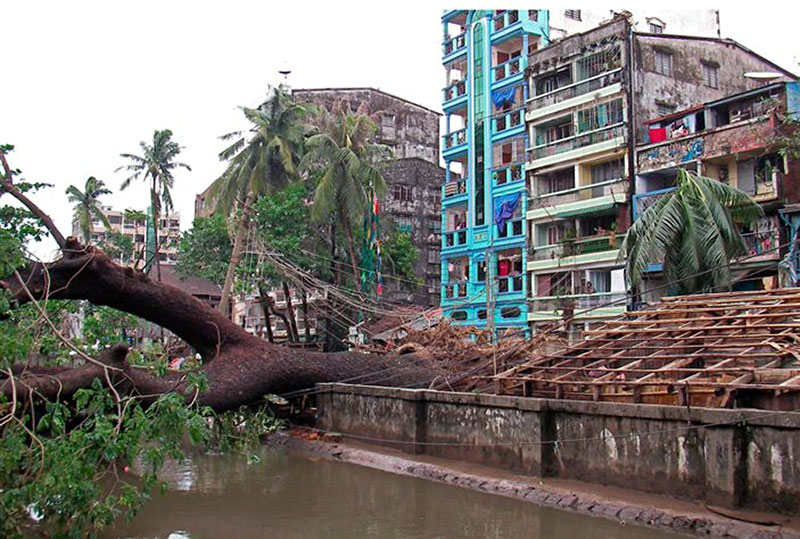
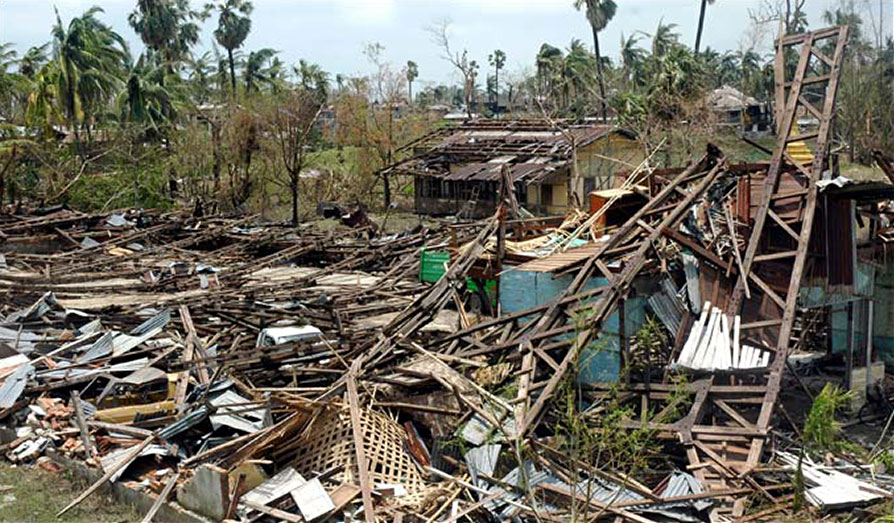
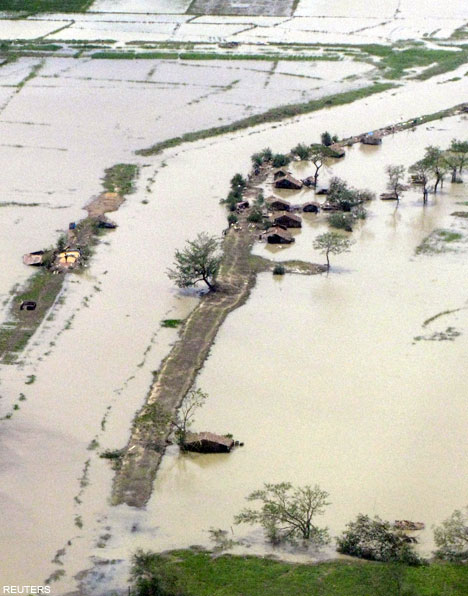 Photo:
Only the roofs stand about the water in flooded
villages around Rangoon
Photo:
Only the roofs stand about the water in flooded
villages around Rangoon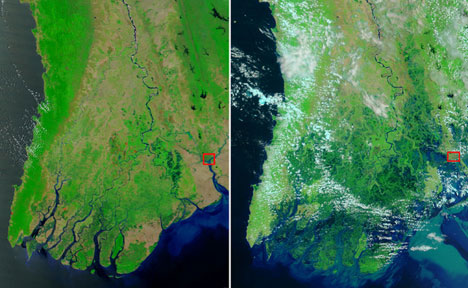
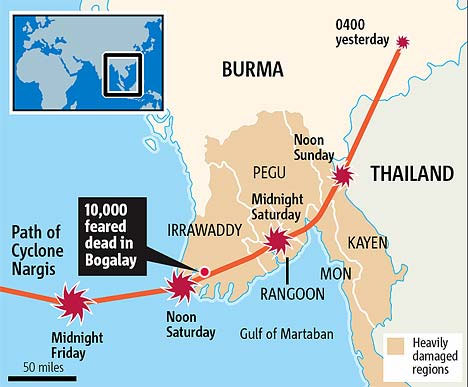
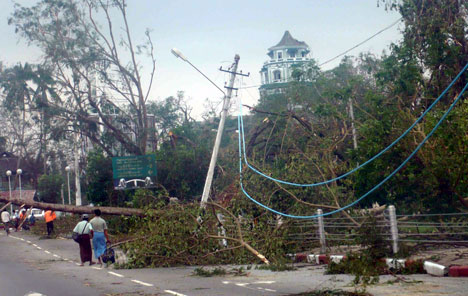 Photo:
Destruction path: locals walk among the electrical
pylons that were felled by the cyclone
Photo:
Destruction path: locals walk among the electrical
pylons that were felled by the cyclone